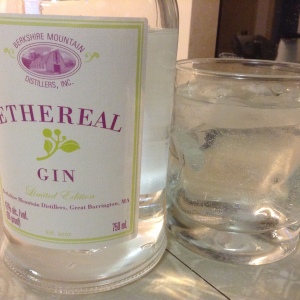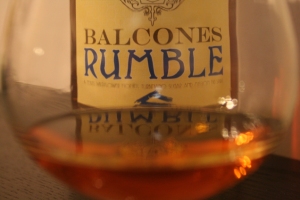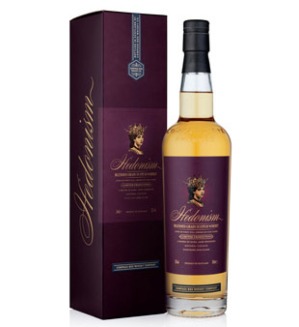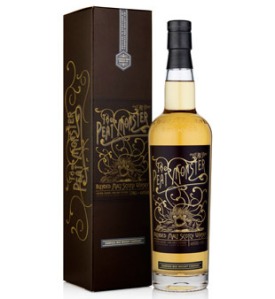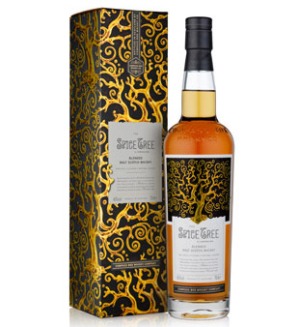Berkshire Mountain Distillers Ethereal Gin
Batch 10
43% abv (86 proof)
$30 – $35
Overall Rating: Bottle
If you haven’t, first read my Intro to help you understand my review system.
When late spring weather turns to the warmer side, I start to crave refreshing drinks. Scotch gets put away at the slightest hint of winter’s passing. Bourbon can be satisfying on ice in the heat, but I tend to enjoy it most during the transitional seasons (spring and autumn). A Mint Julep is a treasure of a cocktail any time in the warm season (even though it’s traditionally used in spring, around the time of the Kentucky Derby), but nothing is so satisfying in the heat, to me, as a chilled beverage accompanied by soda of some kind, and something citrusy. Enter the gin and tonic. Now add my search for really good gin.
I like to buy local when I can help it, even in my travels. Maybe it’s because I live in New England and we have ample supply of ‘local’ goods, or maybe I just like supporting my neighbor, or the little guy. We rely on each other, after all. Regardless of reason, local is my preference when it’s available and priced well (sometimes local is unaffordable). I get into that in slightly more detail here.
Berkshire Mountain Distillers (BMD) is located in Sheffield, Mass, barely outside of Connecticut, my home state. For distilleries, it doesn’t get much more local than that. In Connecticut there is only one legitimate distillery that I’m aware of*, so having a distillery as close as BMD is fantastic.
BMD distills and bottles several products in house including a bourbon (not ‘straight’, so one can only assume it’s quite young), and a corn whiskey. But the subject of this review is not their whiskey. It’s their gin. Ethereal, to be exact, which is a limited yearly release separate from the standard offering, Greylock. I’m reviewing Ethereal, batch 10 (white label; the label changes color with each batch). I couldn’t tell you what year this is from as even BMD’s own website has tasting notes only from batches five through eight (at the time of this writing) and the years aren’t listed anywhere.
As I drink gin almost exclusively in a gin and tonic, I’ll be reviewing this gin based only on its presence in that drink. Here we go…
The eyes.
Clear. It’s gin…
The nose.
Junpier, of course; a little pine-y. Little astringency, though it’s detectable. Pleasantly sweet, slightly citrus, slightly fruity. Barely floral.
The mouth.
Again, please note that I’m tasting this in a gin and tonic, not straight or in a martini. This is sweet. Not overly sweet, but I’d easily categorize this as an Old Tom style gin (not knowing a whole lot about the ins and outs of gin, Old Tom is a sweeter, less dry style). What I’m finding particularly enjoyable about this G&T is that the juniper and light citrus is accompanied by a fruit. At first I would’ve called it blueberry (which goes smashingly with lemon), but the more I drank it the more I became unsure. At this point I’d say it’s definitely a berry. Blueberry, raspberry maybe. Maybe a mixed berry essence. Regardless of the exact source, it’s a hit for me. I tend to enjoy the sweeter style gins, and the combination of juniper, light citrus and berry has me coming back to this for more. After the tiring, slightly warm day I had today, I knew this was exactly what I wanted. Sweet, pleasant, refreshing.
Conclusions:
Were this a standard offering, and not a special release, I would readily recommend it as a stock item. I’d easily keep this on hand. But, given its limited release status and the variations from batch to batch (stated by BMD), I can only recommend this as a bottle purchase. Certainly, to me, worth the price (at the low $30’s mark) of a whole bottle to enjoy. What would move this into a regular purchase would be either my own positive experiences with multiple batches, or recipes (or, at the very least, tasting notes) accompanying each batch. As it is, I have no idea what’s in this batch. All I know is what I’m experiencing which, for me, takes away from it. I want to know. What’s this fruit essence? Is it fruit or is it something else? Is the next batch going to be more on the dry side or are they all sweeter given that Greylock, the regularly available expression, is a London Dry style? Too many questions to make this a regular purchase. More of a curiosity worth a try. Though, in fairness, I’ll likely buy another batch to see how it goes. But as I’ve only experienced one thus far, a bottle recommendation is all I can give it. If you have had, or have, another batch, let me know how it is.
*The only distillery I’m aware of is Westford Hill Distillers in Ashford, Conn, which makes mostly eaux de vie and an aged apple brandy which I have but haven’t yet opened. There are other ‘distilleries’ in CT like Onyx, which purports to be local, but is in fact sourced corn distillate that’s only bottled in state. While that may mean locally bottled, and consequently local jobs (which is great) it’s not a local product. That’s fine, of course, in this capitalist country, but claiming to be ‘Connecticut’s first legal moonshine’ (an oxymoron as ‘moonshine’ is illegal; making it legal removes the moonshining aspect of it, rendering the title meaningless) is a lie. It’s Connecticut’s first legal bottled distillate at best.
